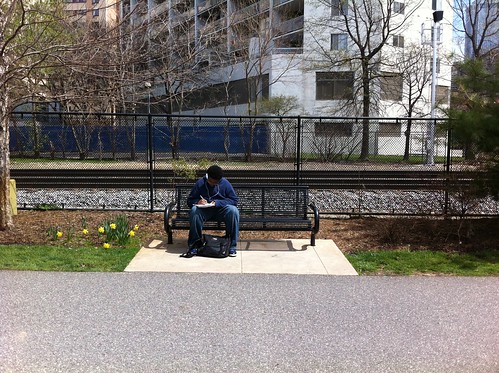Security is when everything is settled. When nothing can happen to you. Security is the denial of life.
– Germaine Greer
I’m not afraid of heights.
Well, my mind isn’t afraid of heights. My legs, I was reminded Wednesday, are afraid of heights.
As part of a new collaboration, all of SLA’s G9 advisories are spending a day of of challenge-based education at Outward Bound Philadelphia.
It was fantastic.
It was hilarious.
The last time I’ve experienced high ropes or other such elements was when I was teaching in Sarasota. Through a partnership with the local YMCA, we took all of our G8 students to climb their Alpine Tower.
The difference between that experience and Wednesday’s was the kids. While not entirely urbanized, many of SLA’s students have seen more cement in their lives than trees. On the 15-minute bus ride to Outward Bound, several students asked where we were and whether we were still in Philadelphia.
“I’ve never been here, Mr. Chase.”
Though it’s not a part of town I visit often, we were riding through neighborhoods I’ve run to from my house.
It was a reminder of how foreign parts of the city remain to students who have lived here their entire lives.
If the neighborhood was foreign, the woods were downright alien to some. The discussion of checking themselves for ticks stopped a group of girls in their tracks.
“Don’t worry,” our guide told us, “They’re everywhere in the city.”
One girl scoffed, “Uh, not around my neighborhood.”
I chuckled to myself.
After some introductory challenges, our group of 40 students were broken in two and my co-adivisor, Matt Kay, and 20 of our students followed Lauren, our guide to the high wire element.
To complete the element’s challenge, two people in full-body harnesses climbed separate ladders to staples about 16 feet up a tree. They continue up the staples to about 25 feet above the ground and then step onto a wire.
The two people work their way down their respective stretches of wire using a robe strung between their two trees counterbalancing one another with their weight.
The two wires are in the form of the two arms of a capital “Y”, and the climbers meet at the access.
From there, the robe won’t stretch any further, and the climbers must count on the weight of each other to counterbalance one-on-one as they make their way along the stem of the “Y” to attempt to touch a third and final rope before being lowered to the ground.
Meanwhile, on the ground, teams of students were on the ground belaying, literally holding their teammates’ lives in their hands.
If I could take students to places like Outward Bound once a month or once a week, I would.
Some of the students made it to the top of the ladder and decided they’d met their challenge. Others made it to the beginning of the “Y’s” stem.
When each one was done, and said they’d gone as far as they wanted to, we encouraged just one step farther.
After that step, their resolve to come back to earth steeled, we lowered them back down and celebrated their victory in meeting their own challenge.
True differentiated instruction.
Back in the classroom today, I started thinking about the implications of a similar approach to teaching. I wonder what would happen if we took kids to where they thought they couldn’t do one more thing, encouraged them to complete that one final assignment and then let them rest, celebrating the victory of how much they’d accomplished.
Often, in my own class, making it one step farther means a student is asked to make it yet another step farther and another step and so on.
While I do all that I can to praise my students and celebrate accomplishments, I could take a page from Outward Bound and let the kids get their feet back on the ground before asking them to take on the next challenge.
I wonder, if we push out kids to new experiences and then offer them a recess of play and reflection if they might not be the better for it.
There’s much to be learned from challenge by choice.
